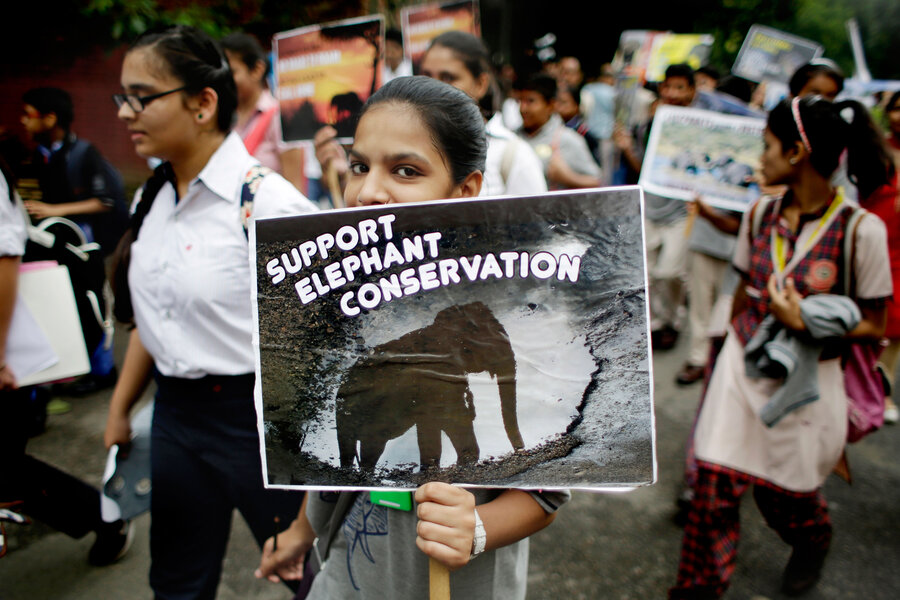World Elephant Day: Why does the world need elephants?
Loading...
Animals lovers around the world are showing their adoration for elephants on Friday, in recognition of World Elephant Day, which has been celebrated on Aug. 12 since 2012.
Despite – or perhaps as a result of – man’s interest in elephant species, their population numbers have witnessed sharp drops in the last few decades.
The organization Born Free suggests that over 129,000 elephants have been poached for their ivory since 2012, and a 2015 report by the Convention on International Trade in Endangered Species (CITIES) estimates that poaching rates exceed the species’ normal growth rate, meaning that poaching still exists above sustainable levels.
Humans love elephants for their grandeur, human-like emotions, and cognitive capacity. Elephants, however, are to be appreciated and protected for more than just anthropocentric reasons, say ecologists.
Adequate forest preservation requires a healthy elephant population. Because of their appetite and migration patterns, elephants disperse more seeds throughout the forest than any other animal. They also deposit over one ton of dung-fertilizer each week.
“This is why ecologists refer to elephants as mega-gardeners of the forest,” explains The Guardian. They are “sowing the seeds of the trees of tomorrow.”
But on World Elephant Day 2016, there are “grounds for cautious optimism,” as National Geographic reports.
According to a report prepared ahead of the 17th meeting of the Conference of Parties in South Africa in September, the Proportion of Illegally Killed Elephants – or PIKE – has dropped to below five percent for the first time since 2009, evidence that population numbers can recover.
And the price of illegal ivory in China – the country that buys the most ivory each year – has been cut in the half during the last two years, according to a December report by Save the Elephants. Experts attribute this price drop to low demand, proof that public awareness campaigns on the ivory trade can work.
There have been other meaningful efforts by individual countries to protect elephants in the past year.
The US Fish and Wildlife Service announced a new ban on interstate sale of ivory in June, equating to an almost-complete can on commercial trade. Now, only pre-existing manufactured items with less than 200 grams of ivory or items over 100 years old can be sold legally. The ban also prevents hunters from bringing home more than two trophies a year.
“Up until now, ivory markets in the US have pretty much had free run,” Jeff Flocken, the North American regional director for the International Fund for Animal Welfare, told The Christian Science Monitor shortly after the ruling in June. “It was very hard to prosecute people for selling ivory because the exceptions and loopholes were so large. The rule that came out and was finalized yesterday really takes a hard look at what is legal and what isn’t, and the as the US government said, it’s a near ban.”
Kenya’s president set fire to 105 tons of ivory in late April, believed to be the largest stockpile ever destroyed. The stack of tusks were accumulated from over 8,000 elephants.
“A time has come when we must take a stand and the stand is clear,” said President Uhuru Kenyatta. “Kenya is making a statement that for us ivory is worthless unless it is on our elephants.”
But some elephant supporters disagreed with Kenya’s ivory burn, arguing that such an act only serves to increase ivory’s value.
Despite recent gains in elephant conservation, it’s too soon to write off the elephant species as safe, conservationists say – a point underscored by a drastic poaching spike from 2009 to 2011.
“These figures should be treated with caution,” National Geographic concludes. “Data on elephant populations, poaching and the ivory trade is notoriously hard to verify, and causal relations between trends almost impossible to prove. Nevertheless the balance of evidence suggests hard work by governments, wildlife protection agencies, NGOs and campaigners in civil society organizations is making a difference. Maybe, just maybe, we have turned a corner at last.”








